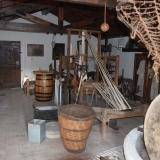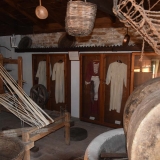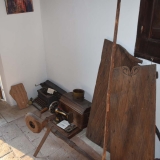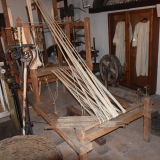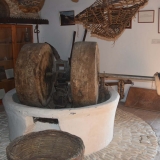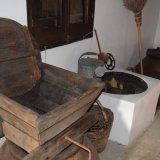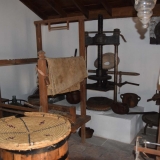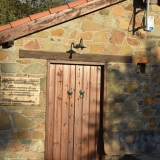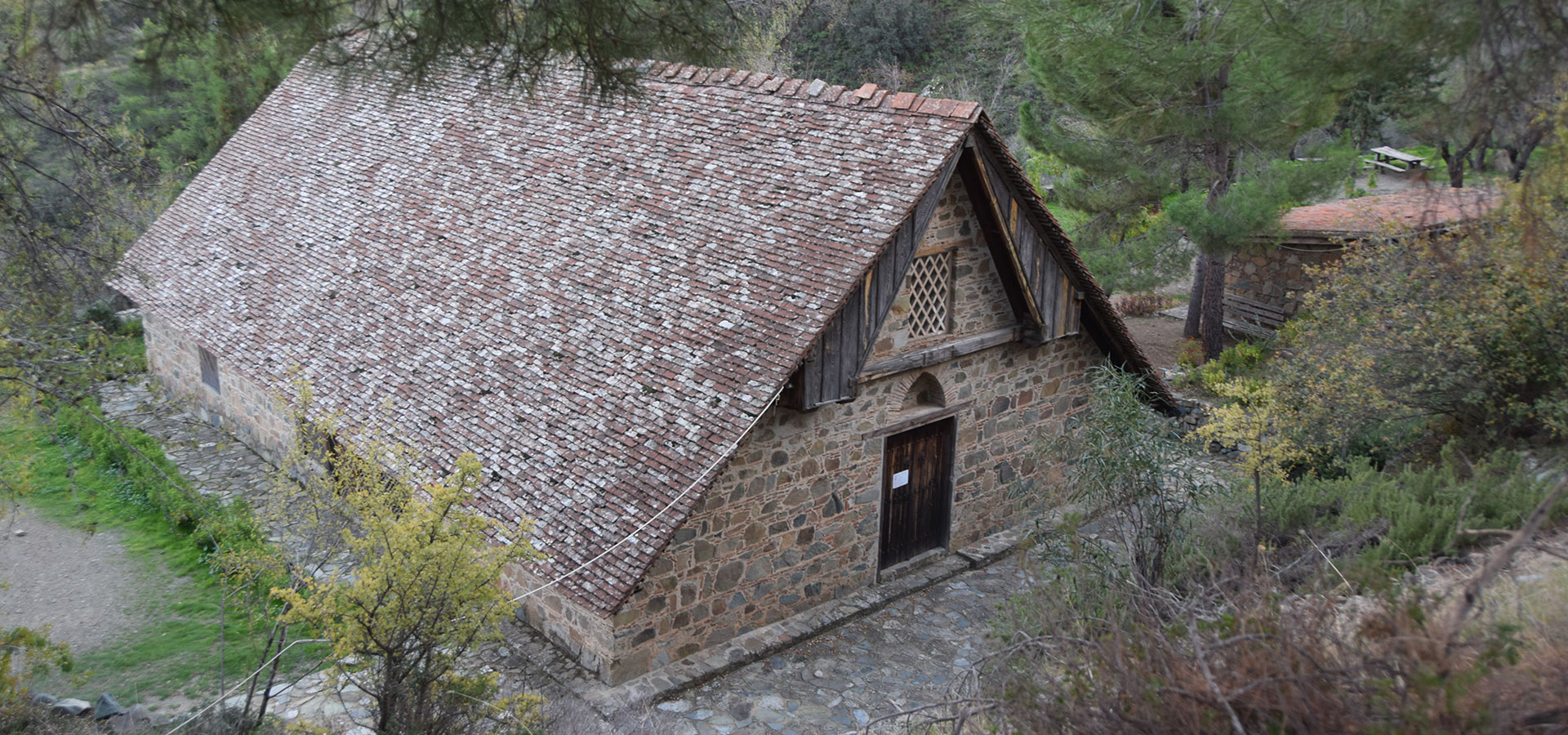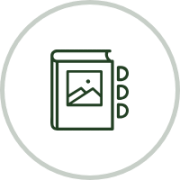Olive Mill
In Platanistasa, in the building where the Museum of Popular Tradition is housed today, there used to be a traditional olive-oil press. It would be interesting for one to get to know the daily routine of the old residents of Platanistasa through the history of the olive oil press. In particular, the museum presents the work done starting from the harvest of the olives until the production of the olive-oil.
From the end of October until the end of February, the villagers would spread all over the olive groves for the harvest of the olives. The harvest called “louvisma” was done by canning the olive trees. In particular, the villagers would use a wooden stick called “vakla” to hit the olive tree so that the olives and some branches would fall on the ground. Once they were finished with the canning of the trees, they would place the branches into sacks and transfer them to their houses with the donkeys. There, they would sort out the olives. Some of the olives would be used for their daily nutrition whereas others for the production of oil.
The olives that were destined for the production of olive would be transferred to the olive mill, the building that contained mill-stones, the presser, and the stony basins for the collection of oil. It is worth mentioning that the old olive-oil press of the village used to be placed inside the yard of the Archangel Michael’s church and it used to serve the needs both of the village and the wider region.
The mill with the two stones, the so called “skoutellin” and the mill stone. “Skoutellin” was a circular stone that was used as a basin and the mill stone was a circular stone that was moved around, according to Ionas, “with the help of the post that went through the centre and touched another standing post that was wedged in the centre of the “skoutellin”. The mill stone was moved by a donkey that was tied at the tip of the post while walking around it. This was done until all olives were pressed and liquidised.
As we have mentioned earlier, another part of the olive mill was the presser. The presser, as it is described with great figurativeness in a leaflet of the Department of Antiquities, consists of a “horizontal base with two vertical posts and a huge wooden screw, which moves in between them pressing the round knittings with holes (zempilia), which were placed one on top of the other on the presser base, with the olive-pulp. A circular channel carved on the base collects the running oil from the “zempilia” and guides it into a clay container sank in the ground called “dani”. To extract all this oil from the olive-pulp, the “zempilia” were pressed for a second time after they were washed with boiled water”.
A study that was provided by the Community Council and was conducted as part of a school assignment, adds that the clay containers which used to be placed on the lower part of the presser and were earlier called “Dani” were also called “galeftirka”.
In particular, the olive oil production procedure was the following: the olives were transferred to the mill with baskets and were placed on the “skoutellin”. Immediately after that, the donkey that was tied on the post would move around the mill to liquidise the olives.
Once the liquidise procedure was over, they were placed in the “zempilia” which look like small netting sacks. These sacks were placed on the wooden screw and men moved it around by holding the handgrips of the screw. As a result, as Iona explains, a mixture of oil and “part of the liquidised olive flesh floated into “dani”. Next, this mixture was transferred to large boilers. The oil on the surface was the best because, according to Ionas, it did not contain “many elements from the core of the olive”. The oil that remained on the bottom of “dani” was placed in the “zempilia” and was pressed again.
The oil was stored in clay pots and then it had to be moved in another container so that its quality was not affected.
Sources:
Ionas Ioannis, Traditional Cyprus Professions, Lefkosia, 2001, pp.487-497
School assignment titled “Traditional Arts”
A leaflet issued by the Department of Antiquities, “Monuments’ International Day”, April 18 2006
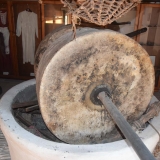
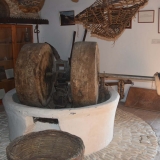
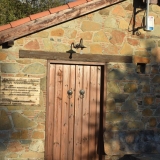
Watermill
One and a half kilometers on the north ,before the entrance of the village Platanistasa, about a hundred meters before the double way that leads from the one way to Platanistasa –Alona and from the other way to the village Alithinou –Livadia –Polystipos ,there is a well – preserved watermill ,which for many years before other means of flour –Pourgouri production existed ,served the villagers’ needs of the area.
This watermill is an excellent watermill model, of rare beauty. It is situated almost one metre above the riverbed, on its south side, opposite of greenery, full of hazel and walnut trees, wonderful scenery. It reminds to the visitor the watermills, at Papadiamantis narrative stories.
The raceway starts from the join of the two rivers (dipotamia) ,the rivers Alona Platanistasa on the one, and Polystipou ‘Livadion –Alithinou on the other. Its length is about two hundred metres and reaches a pretty well preserved water tower of the watermill. From there it flows impetuously from the trapdoor, strikes at the ‘Fteroti’ and moves round the huge watermill stones which oppress the wheat and produce flour or pourgouri (a kind of rice).
The Community Council of Platanistasa decided to expropriate and converse the workshop of traditional flour milling.
The watermill belonged to the church of Archangel Michael of Platanistasa and rented it to people who were millers. Really! How many stories did we hear about this mill, for things and ghosts.
From the church of Archangel Michael it was sold to G. Kasiarti (Troullouri) and from him to the Artist Theodoto Kantho .Today it belongs to Evgenia,the daughter of Theodoto’s Kanthos.
It is everybody ‘s wish for the appropriate arrangements to be done soon ,so the watermill will be restored ,so it will be accessible and to be with the Monastery of the Holy Cross of Agiasmati and the other monuments of Platanistasa an attraction resort for the visitors, for progress and prosperity of Platanistasa.
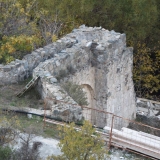
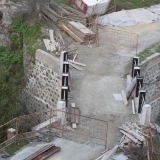
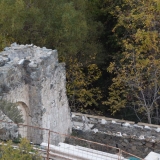
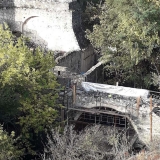
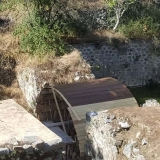
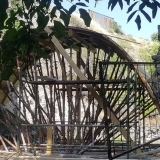
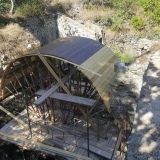
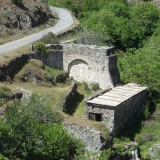
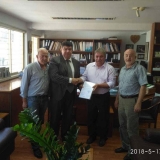
Museum of Popular Art
The Museum of Folk Art is housed in the olive press area. It started its operation in 2000, after six years of maintenance of the olive mill building facilities.
The Community Council and the Cultural Services of the Ministry of Education and the Nicosia District Office contributed to the erection of the Museum.
It includes objects from the olive press area as well as daily items such as cookware, loom, agricultural tools and grapes.
